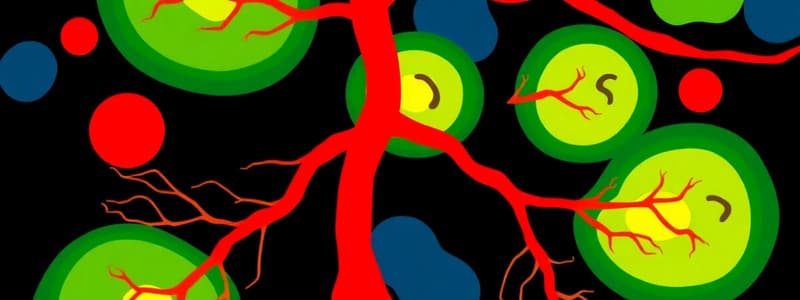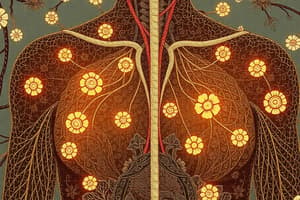Podcast
Questions and Answers
Which of the following statements about the lymphatic system is incorrect?
Which of the following statements about the lymphatic system is incorrect?
- Lymph flow is unidirectional due to valves in the vessels.
- Lymph is colored due to the presence of chylomicrons.
- The thoracic duct begins in the cisterna chili.
- Lymphatic vessels are present in all areas of the body. (correct)
What is the primary function of the thoracic duct?
What is the primary function of the thoracic duct?
- To absorb extracellular fluid from the brain.
- To return lymph to the venous system. (correct)
- To maintain the unidirectional flow of lymph through lymph nodes.
- To transport chyle directly to the small intestine.
Which of the following components is NOT part of the lymphatic system?
Which of the following components is NOT part of the lymphatic system?
- Lymphatic vessels
- Lymph nodes
- Lymphatic ducts
- Epithelial tissues (correct)
What characteristic distinguishes chyle from lymph?
What characteristic distinguishes chyle from lymph?
Which of the following structures is the starting point of the thoracic duct?
Which of the following structures is the starting point of the thoracic duct?
What is the primary role of Type I epithelial reticular cells in the thymus?
What is the primary role of Type I epithelial reticular cells in the thymus?
Which statement accurately describes the significance of the blood thymic barrier?
Which statement accurately describes the significance of the blood thymic barrier?
What may result if developing T-cells fail to recognize self-antigens in the thymus?
What may result if developing T-cells fail to recognize self-antigens in the thymus?
What is the characteristic feature of the medulla in the thymus?
What is the characteristic feature of the medulla in the thymus?
What changes occur to Type VI epithelial reticular cells as a person ages?
What changes occur to Type VI epithelial reticular cells as a person ages?
What is the primary function of the germinal center found in secondary lymphoid nodules?
What is the primary function of the germinal center found in secondary lymphoid nodules?
Which statement accurately describes the fate of lymphoblasts in the lymph node?
Which statement accurately describes the fate of lymphoblasts in the lymph node?
The outer cortex of a lymph node primarily contains which type of specialized cells?
The outer cortex of a lymph node primarily contains which type of specialized cells?
What distinguishes primary lymphoid nodules from secondary lymphoid nodules in terms of composition?
What distinguishes primary lymphoid nodules from secondary lymphoid nodules in terms of composition?
Which region of the lymph node is primarily associated with the presence of T cells?
Which region of the lymph node is primarily associated with the presence of T cells?
What is the primary function of the thymus in relation to T lymphocytes?
What is the primary function of the thymus in relation to T lymphocytes?
Which of the following statements about the structure of the thymus is correct?
Which of the following statements about the structure of the thymus is correct?
Which type of cells support the developing T cells within the thymic cortex?
Which type of cells support the developing T cells within the thymic cortex?
At what point in life does the thymus begin to undergo involution?
At what point in life does the thymus begin to undergo involution?
What component of the lymphoid organ serves as the connective tissue framework?
What component of the lymphoid organ serves as the connective tissue framework?
Flashcards
Lymphatic System
Lymphatic System
The system that transports excess extracellular fluid back to the venous system, collecting large particles like pathogens, cell products, and debris.
Lymph
Lymph
The clear, colorless fluid contained within lymphatic vessels, except for chyle, which is milky due to fat.
Chyle
Chyle
The opaque, milky lymph that is rich in fats, transported from the small intestine.
Lymphatic Ducts
Lymphatic Ducts
The major lymphatic vessels that collect lymph from different regions of the body and drain it into large veins.
Signup and view all the flashcards
Thoracic Duct
Thoracic Duct
The largest lymphatic duct, starting in the abdomen and draining into the left sub-clavian and jugular veins.
Signup and view all the flashcards
What is the thymus?
What is the thymus?
A primary lymphoid organ where T lymphocytes mature. It grows until puberty and then begins to shrink, but continues to function in older adults.
Signup and view all the flashcards
What is the stroma?
What is the stroma?
The connective tissue framework that supports the thymus and other lymphoid organs. It includes a capsule and internal trabeculae for structural organization.
Signup and view all the flashcards
What is the parenchyma?
What is the parenchyma?
The functional cellular part of the thymus and other lymphoid organs. It's divided into an outer cortex and an inner medulla.
Signup and view all the flashcards
What happens to T cells in the thymus cortex?
What happens to T cells in the thymus cortex?
Immature T lymphocytes leave the bone marrow and reach the cortex of the thymus. They undergo proliferation and maturation to become immunocompetent T cells.
Signup and view all the flashcards
What role do epithelial reticular cells play in the thymus?
What role do epithelial reticular cells play in the thymus?
Epithelial reticular cells in the thymus cortex form a network that supports the developing T cells. They help guide the T cells to the medulla.
Signup and view all the flashcards
Type I Epithelial Reticular Cells
Type I Epithelial Reticular Cells
Specialized epithelial cells in the thymus that create a barrier preventing foreign antigens from reaching developing T cells in the cortex.
Signup and view all the flashcards
Blood-Thymus Barrier
Blood-Thymus Barrier
A barrier that protects developing T cells in the thymus from exposure to foreign antigens circulating in the blood.
Signup and view all the flashcards
T Cell Education
T Cell Education
A process within the thymus that allows developing T cells to learn to distinguish between self-antigens and foreign antigens.
Signup and view all the flashcards
Hassall's Corpuscles
Hassall's Corpuscles
Unique structures in the medulla of the thymus, formed by epithelial reticular cells, which are thought to play a role in the final stages of T cell development.
Signup and view all the flashcards
Naive T Lymphocytes
Naive T Lymphocytes
Immature T cells that haven't yet encountered antigens and are ready to be activated by an immune response.
Signup and view all the flashcards
What is the cortex of a lymph node?
What is the cortex of a lymph node?
The outer region of a lymph node, containing B cells clustered in primary and secondary lymphoid nodules.
Signup and view all the flashcards
What is the germinal center?
What is the germinal center?
The central area of a secondary lymphoid nodule where rapidly dividing B cells respond to foreign antigens.
Signup and view all the flashcards
What happens to plasma cells in the medulla?
What happens to plasma cells in the medulla?
Plasma cells migrate and produce antibodies in the medulla. Some remain in the medulla and release antibodies into lymphatic sinuses.
Signup and view all the flashcards
What is the Paracortex?
What is the Paracortex?
The central region of a lymph node, containing T cells and the thymus-dependent zone.
Signup and view all the flashcards
What is the stroma in a lymph node?
What is the stroma in a lymph node?
The stroma provides structural support and organization within lymph nodes, with a dense connective tissue capsule and incomplete trabeculae.
Signup and view all the flashcardsStudy Notes
Lymphatic System Overview
- The lymphatic system returns excess extracellular fluid to the venous system.
- Lymph is the clear, colorless fluid carried by lymphatic vessels; chyle is milky lymph from the intestines.
- Lymphatic vessels are absent in the brain, bone marrow, and avascular tissues (e.g., epithelium, cartilage).
- Lymphatic flow is one-directional and maintained by valves.
- Lymph nodes filter lymph, playing a role in immune responses.
- Lymph nodes are small, encapsulated structures along lymphatic vessels, with a convex outer surface and concave hilum.
Specialized Immune Tissue
- Lymphoid organs consist of a stroma (connective-tissue framework) and parenchyma (functional cells).
- The thymus is a primary lymphoid organ where T lymphocytes mature.
- Thymus tissue includes cortex and medulla regions (Hassall's corpuscles).
- Lymph nodes filter lymph and contain lymphocytes, macrophages, and plasma cells.
- Lymph nodes consist of cortex, paracortex, and medulla, supporting different lymphoid function.
- Primary lymphoid nodules have small B cells, macrophages, and follicular dendritic cells.
- Secondary lymphoid nodules have a germinal center of proliferating B cells, creating plasma cells and memory B cells.
Clinical Correlations
- Lymphangitis and lymphadenitis are inflammation of lymphatic vessels and lymph nodes, respectively.
- Lymphedema is a localized swelling due to impaired lymph drainage.
- These conditions may result from infections or obstructed lymphatic vessels.
Studying That Suits You
Use AI to generate personalized quizzes and flashcards to suit your learning preferences.




